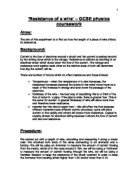Current flowed through the wire with a reading on the ammeter; then we changed the length of the wire by moving the clips closer together. I predict that as we are changing the length of the wire, i.e. making it shorter, the resistance will stay the same regardless of the wire length, because we will change the variable resistor to keep the same resistance of in this case 0.19, and to make sure the ammeter does not read above 1.0A and/or below 0.1A. With each change in the length of the wire, we then read off another ammeter reading, and with a voltmeter we read off the voltage of the mains then divide that by the amps to get the resistance for that length of wire.
We decided to use the range of one meter for the experiment, mainly for accuracy. The extent of our results, was that we did the experiment initially, then we did it a further two times; we needed to do this to make sure that the experiment was a fair test, so we needed more then one copy of the results, to make sure we got a correct range of results, we did not want a very big variation.
Strategy:
- We assembled the circuit, and set up as shown in the diagram. It is obviously important to assemble the circuit correctly, otherwise the experiment will not work effectively:
-
We then turned everything on, and took our first reading of the voltage and the amperes of the length of wire of which was initially set to one meter in the beginning stages of the experiment; we started off with the length of wire as one meter, so that we got a good range of results.
- As we continued to take readings, we shortened the length of the wire by 3 centre meters every time we took a reading off the ammeter and voltmeter; this was so that we not only got a good range of results, but also eventually the resistance of each length of wire, and make our analysis on the way the length of wire affects the resistance.
- We needed to make sure that the ammeter did not reach either below 0.1A or above 1.0A otherwise this would cause damage to the wire and ruin the experiment, forcing us to start it all over again.
- When we got to the end of the experiment, we checked the results that we had received, to see if whether or not there were any anomalistic results which were largely off the majority best-fit line.
Fair Test:
I am going to investigate what factors affect the resistance of a wire. There are four main factors which affect the resistance of a wire:
-
The temperature of the wire. (How hot the wire gets, if the wire increases in temperature during the experiment, this will increase resistance and the wire may become damaged)
-
The thickness of the wire. (The diameter of the wire)
-
The material of the wire. (What the wire is made out of)
-
The length of the wire. (How long the wire actually is at the start and end of the experiment) This is the variable we are testing.
I predict that in order to make the experiment a fair and even test, each of the first three factors mentioned above must be kept constant, whilst we experiment with the length of the wire. Otherwise, if additional factors are affecting the experiment as well as altering length, we would not truly be able to conclude how the length affects resistance. The results would be inaccurate and in other words, this would make the experiment null and void.
Predictions:
- The longer the wire, the higher the resistance. This is because the longer the wire, the more times the electrons will collide with each other as well as the atoms in the metal wire.
- Changing the length of the wire will change the resistance of the wire. For example doubling the wire’s length will double the resistance. Halving the length of the wire will also halve the resistance.
- My graph should show that the length is proportional to the resistance.
Also when we change the length of the wire the resistance will affect it less, so with using the Variable Resistor we can increase the resistance.
Observations:
These are some simple safety procedures that must be and were followed during the experiment in order to keep it fair, safe and smooth running:
- The wire must not be touched throughout the experiment as it may become hot at any point.
Analysis:
The results that we received from this experiment to investigate the ways in which the length of a wire affects the resistance of it, showed exactly that.
As shown in the Graphs below; you can clearly see that the trend is as the length of the wire decreases the resistance of it increased.
There was only really one main trend shown in the results, and that is that as I mentioned above, about the fact that the length of the wire affects the resistance of it.
Equations used:
To find the resistance of a length of wire, we divided the current by the voltage; we did this constantly throughout the experiment.
Results Table 1:
Results table 2:
Graphs 1:
Graphs 2:
Graph Conclusion:
The results that we both received from doing the experiment, and from the graphs shown above, all indicate that the gradient is negative; i.e. as the length of the wire decreases, the resistance of it increases, this is because there is physically less space in the wire for the electrons to move through, thus causing electrical friction inside the wire, which leads to the wire glowing as the temperature increases.








